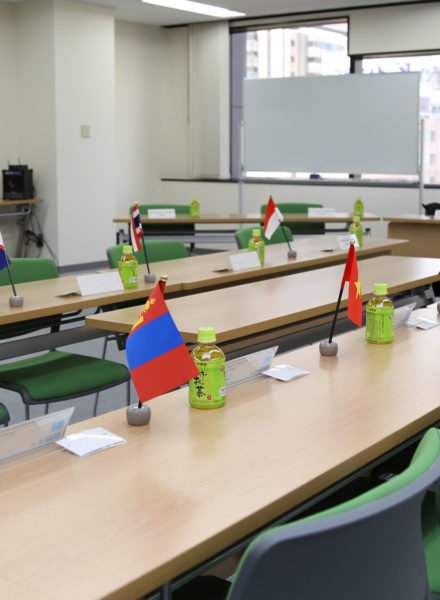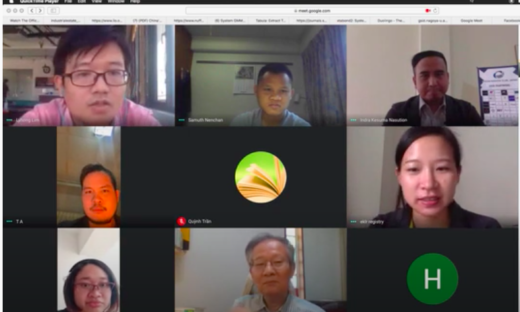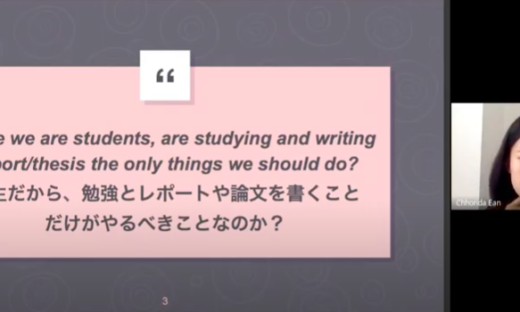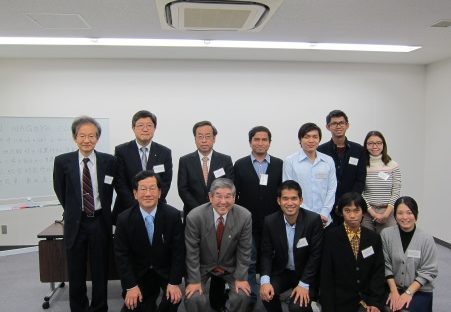第14回ミーティング報告書 2015年9月22日 (The 14th Meeting Report September 22, 2015)
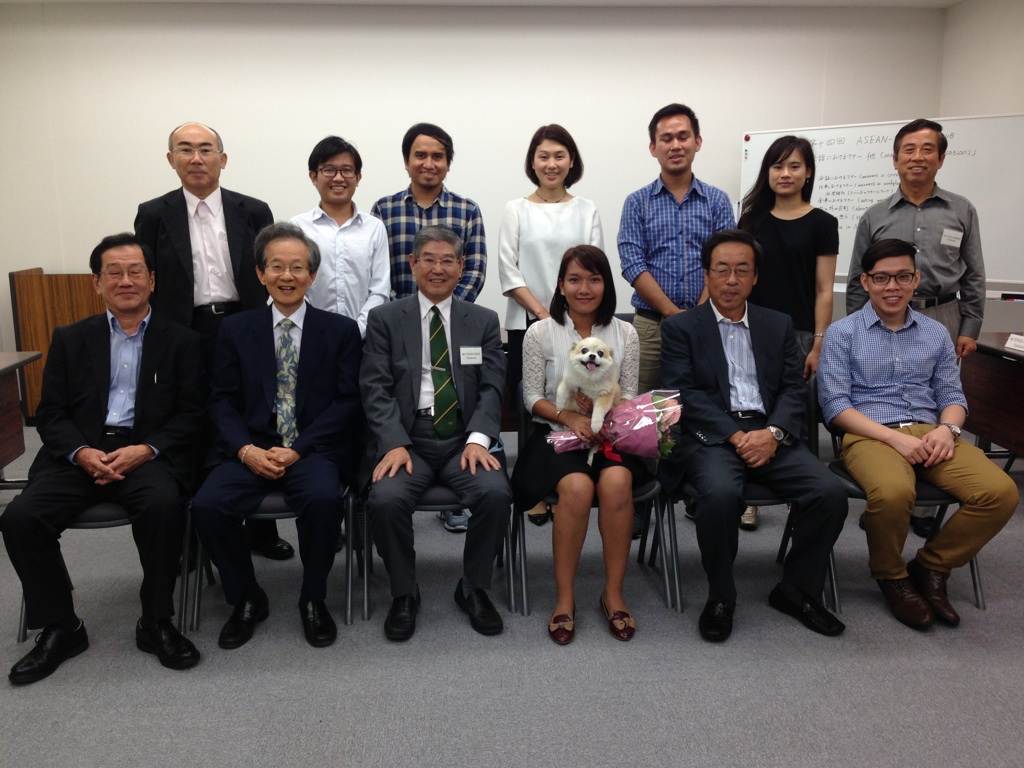
日本人のマナー
ASEAN-NAGOYA CLUBの第十四回目です。本日は荻巣先生、島津先生ともに、海外ご出張です。留学生も6名が帰国中です。今日のテーマは、日本人のマナー。日本の文化は独特で、世界の人から分かりにくいという声がありますが、留学生のみなさんは、逆に、日本のマナーを身に付けたいと考えておられます。マナーの話しは非常に裾野が広く、深く、1回ではとても理解できませんが、今日は、留学生が戸惑う日本人のマナーについて触れてみます。
「日本人は相手の目を見て話さない」という質問が挙がりました。現在は、相手の目を見て話すのは基本ですから、そのような質問に違和感を感じる日本人も多いと思います。しかし、平成初期、昭和の時代を振り返れば、心当たりがある人が多いのではないでしょうか。
日本人OBから日本社会の背景について説明がなされました。武士道です。武士道では目上の人からお話しがあっても、顔を見ないという作法がありました。目を見て身分の高い人とお話しすることは、大変無礼なこととされました。江戸時代の身分制度は、話しの仕方のついても、作法がありました。殿様から家臣(部下)に言い伝えるとき、お目見えといい、殿様の顔を見ていい人と、いけない人の階級に分かれていました。顔を見ていい人でも、首から下しか見ない。顔は見ない。通訳がいて伝えるのが基本でした。100年ちょっと前の話です。そんなに遠い昔の話ではないのです。こうした文化伝統が、日本人の所作に影響してきたことでしょう。海外では目をそらして話すのは、怪しいという印象をもたれますが、昔の日本では、目を見て話しをすることが、怪しいという印象につながったということです。
次に、「日本人との会話の中で、聞いてはいけないことがあるように思います」。それは、どのようなことですかという質問がありました。留学生には、聞いてよいことと、いけないことを区別するのは、とても難しいことであるに違いありません。
日本人は、プライベートなことをあまり聞きません。例えば、同じ会社の中でも、給料はいくらかというのは、お互いに聞きません。お金の話をする人は、評価されない歴史があります。江戸時代の士農工商という身分制度にも明らかなように、お金にかかわる身分は、最も卑しいものとされてきました。明治、大正、昭和初期に生まれた人たちには、こうした気風が色濃く残り、「お金の話は、品格がない」とされてきました。次に、日本人は、「結婚しましたか、子どもがいますか。何歳ですか」などと、相手方の近況を聞くことをしません。日本人は、こういうことを聞きません。日本人は、自分の事を語りません。日本人は、公のこと、全体のことを中心として生きている人が多い、というのがその理由です。東日本大震災で辛い目に遭った人が、誰かに会うときは、笑顔を絶やさず、自らの悲しい出来事を、表に出さないというのもそうした傾向だといえます。
留学生にはわかりづらい日本文化です。聞かなければ分からない日本人のマナーは、たくさんあります。そうした中で、デパート出身のOBから、貴重なお話しをお聞きすることができました。日本人のマナーを理解する上で、デパート文化はとてもよい例となります。デパートには、江戸時代から脈々と続く文化があります。まず、お客様は、すごく大切で、偉い人であるという認識があります。極端に言えば、「足をふまれても、ありがとうございます」という姿です。デパートにおいて、マナーを学ぶことは仕事でもあります。入社すれば、何もせずに、ひたすら先輩の姿を見て、真似て、学ぶ。昔は、これを1年、2年かけて見習いをしたそうです。日本のマナーを学ぼうと思えば、デパートで見習いをするのが相応しいのです。女性がお嫁入り前に、デパートで行儀見習いをすれば、お嫁に行く資格が十分に備わるというものでした。お花の稽古、料理、お茶、生け花、着物を縫う。ありとあらゆる行儀作法を身につけることができたそうです。
デパートには、5大接客用語があるそうです。「いらっしゃいませ」。「ありがとうございます」。「恐れ入りますが」。「申し訳ございません」。「またお越し下さいませ」この5つを毎朝、45度、30度、15度というお辞儀の角度を伴い、何度も何度も唱和していくのだそうです。こうしたトレーニングで、「スマイル、スピード(お客さんはもたもたしているのを一番いやがるといわれます)、最後にsincerity(真心を込める)」という3つの理念を実現していくことになります。これらの全体が「日本のおもてなし」となるのです。ここでは、詳しく触れませんが、隠語があります。お客様に失礼にならないように、多くの隠語を駆使した社内のコミュニケーションは、芸術的とさえいわれるものです。このおもてなしの極致に、日本人OBも感動しました。
今日は、カンボジア留学生、スレイデンさんの卒業です。スレイデンさんの卒業のために、仲良しのチワワのゴマちゃんがかけつけてくれました。日本をこよなく愛するスレイデンさんは、きっと、またいつの日にか日本に戻ってくることでしょう。
Japanese Etiquette
This is the 14th time of ASEAN-NAGOYA CLUB. Today, both Professor Ogisu and Professor Shimazu are on a business trip overseas. Six international students are returning to Japan. Today’s theme is Japanese manners. Some people around the world say that Japanese culture is unique and difficult to understand, but international students, on the contrary, want to learn Japanese etiquette.
1. Direct Eye Contact
The question is that why do Japanese people avoid having direct eye contact? In general, Japanese don’t stare at the other party’s eyes at the time while talking. it is considered uncomfortable to be done so unless they are very intimate or they are seriously discussing an important issue.
A Japanese OB (alumni) explained the background of Japanese society. It is Bushido. In Bushido, there was a principle of not seeing the face even if there was a talk from a superior. It was very rude to look at and talk to a high-ranking person. The social division system of the Edo period had a method of speaking. When the lord told his vassals (subordinates), he was divided into a class of people who could see the lord’s face and those who couldn’t. Even people who can look at their faces only look down from their necks. These cultural traditions may have influenced the behavior of the Japanese. Talking with your eyes away can give you the impression that it is suspicious, but in Japan in the past, talking with your eyes led to the impression of being suspicious.
One way to cope with this difficult situation is to look at the eyes and then away or preferably down before looking again. This doesn’t mean that you should stare at your shoes. You can look at various places on the face before looking back at the eyes. For example, eyebrows, mouth area etc. Try this simple rule: limit eye contact to 25% of the time.
However Eye Contact in Business Related Situations is important. Things are never quite as cut and dried as they seem. Anyone aware of Japanese etiquette to even a limited degree will know this. One area where increased eye contact is important is in business negotiations, meetings and teaching job interviews. In these situations, avoiding eye contact is perceived as the applicant or business partner “hiding something” or is possibly being deceptive.
2. Discussing about Personal Things
Japanese isn’t comfortable to talk about personal matters. They aren’t preoccupation with age, marital status, and children. These ideas are quite personal and usually have no bearing on a conversation between two people who have just met, other than if they are hitting on each other. Asking questions such as “How old are you? Are you married? How many children do you have?” are considered personal questions. The Japanese people don’t feel comfortable talking about themselves. They want to look happy by not revealing their personal circumstances.
Another example, even within the same company, we don’t ask each other about the amount of the salary. In the Edo period, a person’s status in society was determined by the amount of salary. People born in the Meiji, Taisho, and early Showa eras have a strong sense of this, and it has been said that the story of money is dignified.
3. Department Store Etiquette
Department store customer service is a great example of understanding Japanese etiquette. Department stores have etiquette that has been continuing since the Edo period. The first department stores in Japan were founded during the early 1900s. Their predecessors were kimono stores, which supplied various types of luxurious goods during the Edo and Meiji periods. Japanese department stores were largely successful for decades.
Japanese department stores are famous for their unparalleled customer service. The constant greeting by the staff is a distinguishable feature. If you visit a big department store just before it opens, you would usually see its employees lined up neatly, waiting to welcome customers. The moment the second hand of the clock hits the opening time, the doors will be punctually opened, and customers can make a grand entrance being flanked by bowing and greeting staff.
The elevator girls are another unique characteristic. They are female staff, neatly dressed in uniform with the task to tend to the elevators. They provide relevant information to customers as the elevator goes through the different levels and act according to requests by customers to alight at specific floors. Unfortunately, the number of elevator girls has decreased in recent times, but they can still be found at some of the bigger stores in Tokyo and Osaka.
Learning etiquette in a department store is also a good job. Once you join the company, you can just learn from your seniors, imitate them, and observe them. If you want to learn Japanese etiquette, it is appropriate to apprentice at a department store. It was said that if a woman had an apprenticeship at a department store before she got married, she would be fully qualified to be a good wife. Women sew flower arrangements, cooking, tea ceremony, and kimono. It seems that women are able to learn all kinds of manners.
It seems that department stores have five major customer service terms. “Welcome”. “Thank you”. “Excuse me”. “I’m sorry”. “Please come again.” These five are spoken over and over again every morning with bowing angles of 45 degrees, 30 degrees, and 15 degrees. Through such training, we will realize the three philosophies of “smile, speed (customers are said to be the most reluctant to hold back), and finally sincerity”. All of these are “Japanese hospitality”.
Today is the graduation of Ms. Sreyden, an international student from Cambodia. Goma-chan, a good friend of Chihuahua, came to congratulate Ms. Sreyden’s graduation. Ms. Sreyden, who loves Japan, will surely come back to Japan someday.
参加者:
<日本人メンバー>
小里氏、西氏、鈴木氏、大黒氏、春名氏、箕浦氏、山村氏、松久氏(コーディネーター)、田中氏(スタッフ)
<留学生メンバー>Mr.Indra Kesuma Nasution、Mr.Lim Lyhong、Mr.Chheourn KuyEng 、Ms.Sreyden Vong、Mr. Nguyen Huu Phuc、Ms. Trang Thu Tran
Participants:
Mr. Ori, Mr. Nishi, Mr. Suzuki, Mr. Oguro, Mr. Haruna, Ms. Minoura, Mr. Yamamura, Mr. Matsuhisa (coordinator), Mr. Tanaka (staff)
Mr. Indra Kesuma Nasution , Mr. Lim Lyhong, Mr. Chheourn KuyEng, Ms. Sreyden Vong, Mr. Nguyen Huu Phuc, Ms. Trang Thu Tran

